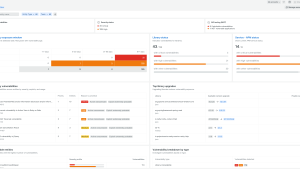In our ever-evolving digital landscape, where data's value rivals that of gold, it's essential to protect this treasure. As cyberthreats continue to advance, merely traditional defenses aren't cutting it. Enter the realm of security analytics: an assertive, data-inspired method that propels organizations to anticipate, dissect, and confront potential risks before they escalate. Amplify your security strategy by shifting from responsive to predictive, leveraging your data as a dynamic force in battling cyberthreats. With the right toolkit and techniques, security analytics can stand as your organization’s digital sentinel, constantly ensuring your data's integrity and operations' continuity.
What is security analytics?
At its core, security analytics employs sophisticated data methodologies to shed light on an organization's safety. By aggregating and scrutinizing data—from network activities, user interactions, and system trends—it detects unusual patterns that hint at a security breach. As cyberattacks multiply and evolve, security analytics becomes the vigilant eye, perpetually on the lookout, offering actionable intelligence to thwart breaches in their infancy. It’s not merely about creating higher barriers; it’s about comprehensive insight, readiness for potential incursions, and crafting timely, efficient countermeasures.
Navigating modern security challenges
In our fast-paced cyber era, threats have transformed from isolated incidents into intricate campaigns, often steered by organized entities or even countries. These threats exploit an array of vulnerabilities, targeting technological and human facets alike. While foundational security tools like firewalls remain indispensable, they’re not the end-all solution. The true test lies in an organization's agility in spotting and countering these challenges. Here, security analytics shines. Functioning as an always-on, dedicated security expert, it ceaselessly evaluates an organization's security, delivering timely alerts for potential concerns. In a world where data breaches can have sweeping ramifications, security analytics propels organizations to take charge, morphing data from a possible weakness to a fortified defense.
Key components of security analytics
Security analytics fuses technology, know-how, and strategy. Let’s unpack the critical facets that shape an effective security analytics framework.
- Data collection: The journey starts here. Gathering diverse information paints a holistic view of the organization's digital climate, much like assembling a jigsaw puzzle, where every data fragment offers insights.
- Data integration: Once collected, data should mesh seamlessly. This step ensures disparate data sources coalesce into a single, cohesive framework.
- Analysis and detection: Built on integrated threat intelligence, this phase utilizes advanced algorithms and machine learning, but it's crucial to blend technological prowess with human insight. Together, they sift through data nuances, pinpointing potential threats.
- Response and resolution: Upon detecting a threat, swift action is paramount. This can range from automated reactions to manual interventions.
- Continuous improvement: In the ever-shifting landscape of security, evolution is key. Regular reassessments and adaptations ensure the security measures remain robust.
- Reporting and compliance: Beyond ensuring safety, modern businesses must also validate their security protocols. Hence, detailed records become imperative for stakeholder transparency and regulatory compliance.
Each element is pivotal, collectively crafting a holistic security strategy, designed to anticipate and nullify threats before they gain traction.
The benefits of harnessing security analytics
Embracing security analytics is akin to supercharging your organization's defense capabilities. Integrating it means not just augmenting your defenses but elevating your entire security paradigm. Benefits include:
- Proactive detection: Anticipate and address threats before they escalate.
- Risk reduction: Diminish the chances of successful cyberattacks through vigilant monitoring.
- Compliance assurance: Effortlessly meet regulatory demands with real-time, detailed reports.
- Operational efficiency: Streamline security data management, empowering your team to strategize.
- Cost effectiveness: Early threat detection can sidestep substantial breach-related costs.
- Reputation building: Showcase your security commitment, cultivating trust and enhancing your brand image.
In our digitized era, where cyberthreats loom large, security analytics offers the sharp, proactive edge organizations need.

How to make the most out of security analytics
To fully harness the power of security analytics, it’s not enough to simply implement a solution and let it run. Security analytics is a tool, and like any tool, its effectiveness is determined by the skill and strategy with which it is used.
Here’s how to ensure you’re squeezing every ounce of value from your security analytics investment:
- Establish clear objectives: Start with a clear understanding of what you want to achieve with security analytics. Are you focused on compliance, threat detection, incident response, or a combination of these? Setting specific, measurable goals will guide your implementation and help you measure success.
- Integrate comprehensive data sources: The more data your security analytics platform has access to, the more accurate and insightful its analysis will be. Integrate logs, network traffic data, user behavior data, cloud-based data, and other relevant information to create a rich, comprehensive data environment. By including data from cloud services, you can achieve a more holistic view of your security landscape, which will enhance your platform's effectiveness.
- Regularly update and fine-tune your models: Cyberthreats are constantly evolving, and your security analytics platform needs to evolve with them. Regularly review and update the algorithms and models your platform uses to ensure they remain effective against the latest threats.
- Train your team: Security analytics tools are most effective when your team actually knows how to use them. Invest in training for your security staff to ensure they understand how to use the tools effectively and can interpret the insights they provide.
- Act on insights: Security analytics can provide a wealth of information, but it’s only valuable if you can act on it. Establish clear protocols for how your organization will respond to the insights generated, whether that’s patching a vulnerability or investigating a potential breach.
- Review and iterate: Regularly review the performance of your security analytics initiative. Are you achieving your objectives? What can be improved? Use these reviews as opportunities to refine and improve your approach.
- Collaborate and share intelligence: Cybersecurity is a collective challenge. Collaborate with other organizations and industry groups to share threat intelligence and best practices. This collaborative approach can help you stay ahead of emerging threats.
- Leverage expert partners: Consider working with experienced partners, like New Relic, who can provide additional expertise, insights, and support. An expert partner can help you avoid common pitfalls and ensure the success of your security analytics.
By taking a thoughtful, strategic approach to security analytics, you’re not just installing a piece of software—you’re embedding a powerful, proactive security posture into the very fabric of your organization. It’s about turning data into a steadfast ally in your ongoing mission to protect your digital assets and maintain the trust of your stakeholders.
The future of security analytics with IAST
Interactive application security testing (IAST) propels security analytics. Seamlessly integrating static and dynamic testing, IAST provides developers with real-time feedback on potential vulnerabilities. With New Relic IAST, security isn't an afterthought—it’s woven into software development, equipping engineers to intrinsically fortify applications.
In this dynamic digital age, we stand ready, committed to helping enterprises pivot from viewing security as a challenge to leveraging it as an edge. Join us on this transformative journey, optimizing your security data analytics to its fullest potential.
Next steps
Learn more about New Relic IAST.
Sign up for a free account today to take advantage of IAST and the 30+ other capabilities of the New Relic platform. Your free account offers 100 GB/month of data ingest, one full-platform user who can use all of our tools, and unlimited basic users who can view your data and insights.
The views expressed on this blog are those of the author and do not necessarily reflect the views of New Relic. Any solutions offered by the author are environment-specific and not part of the commercial solutions or support offered by New Relic. Please join us exclusively at the Explorers Hub (discuss.newrelic.com) for questions and support related to this blog post. This blog may contain links to content on third-party sites. By providing such links, New Relic does not adopt, guarantee, approve or endorse the information, views or products available on such sites.



